The Critical Motion of the Arm
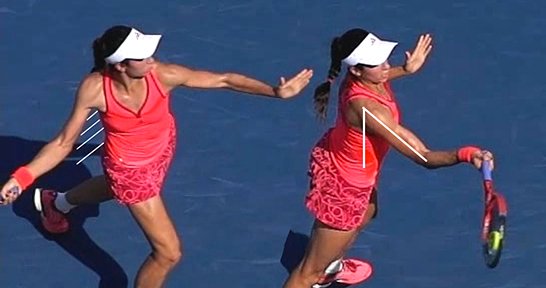
In my recent article on Misunderstanding Leverage, I used the clip of a student making the very common mistake of trying to take a big backswing and "swing fast" into contact. I suggested that this idea of big, fast swings usually ends up destroying the stroke because proper leverage never gets established. A lot of effort is expended, but the "free" power from meeting the ball in front, and maximizing compression of the ball with the arm and shoulder behind impact, is not achieved.
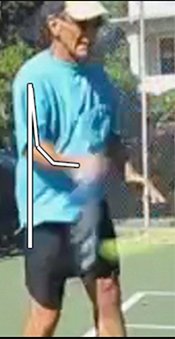
The inability to establish leverage is usually compounded when instructors emphasize the "stretch shortening cycle" and "snapping the cap". The stretch shortening cycle is important, but if the player does not have leverage, does not meet the ball out in front with the shoulder and arm behind the ball, concepts like the "stretch shortening cycle" will only hurt the stroke. And in my experience filming players, it is this positioning of the arm on impact that is off. When you are not positioned correctly behind the ball on contact, you severely compromise the compression and spring of the ball, and you also compromise your ability to push through the ball from the shoulder. This results in an enormous loss of power.
I captured a wonderful video of Christina McHale from an overhead angle a few years ago, and took two stills from the clip to show how the arm works to establish leverage behind the ball. In the frame on the left, I drew white lines to show the space between her arm and her body in the takeback. In the second frame on the right, I drew a triangle to show how her arm has been pulled very far forward, so that when she meets the ball, her upper arm is at a 45 degree angle to her body. As the ball presses into the string bed, it is being supported by her hand, entire arm, and shoulder. Notice the face it principle as well - she has turned her shoulders so that they face the net on impact.
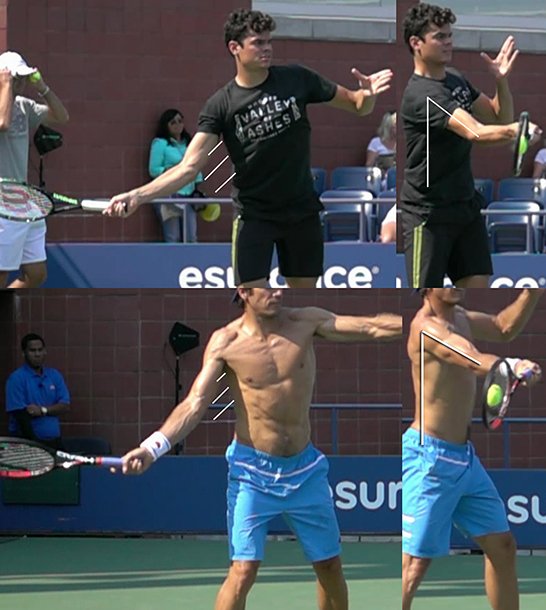
Finding the Ball
This idea of hitting out in front has always been a staple of tennis instruction. When Boris Becker was asked what his best tip for a good forehand was, he said that great forehands have a lot of variety in backswing and grip, but at the pro level everyone "hits the ball early". He said that his coach didn't care about the takeback but focused on early contact point and the follow through. I see this over and over again: people with good forehands had a coach who emphasized the contact point and the motion through the ball as opposed to the swing into the ball. People with bad forehands were taught with an emphasis on a big backswing and fast racket head speed into contact.
In the stills to the left I compare Milos Raonic and Tommy Haas using the same markers I used in the McHale picture. When the racket is back, there is space between the upper arm and body. On contact, the shoulders have turned into the ball and the arm has pulled very far forward. The upper arm and the side of the body form a 45 degree angle.
With my new high speed camera, you can really see how the ball squashes into the string bed on contact. For a great forehand, the arm has to have moved well in front of the body so that the racket, arm, and shoulder behind the ball as it compresses. From this powerful position, the player can push from the shoulder for power and turn the hand for topspin.
I think the problem today is that hitting out in front is not an exciting concept. It is much sexier to say "snap the cap" or use the "stretch shortening cycle". Or "maximize head speed". These are the cool hip terms I find over and over again today. But my suggestion to you is to video tape your forehand and see if you are meeting the ball out in front with your arm and shoulder behind the ball. If not, it is likely that you are working hard and swinging fast, but you aren't tapping into the same power source as the pros.
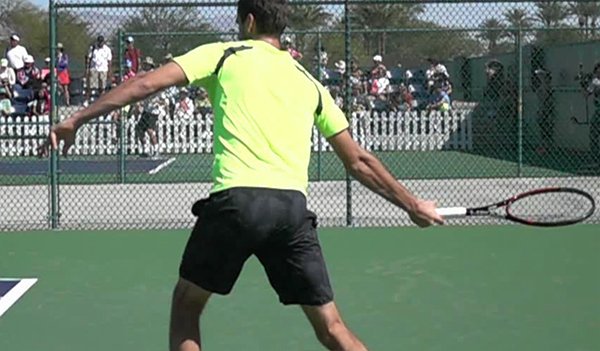
With the Cilic still on the right, I really like studying forhands from this angle. It really shows you how the arm moves from behind the body to well in front of the body. Mouse over this still of Cilic to see how he moves his arm from behind his body to well in front of his body at impact. From that leveraged position on contact, he can push forward from the shoulder and he can turn his hand, especially with the racket being angled so far below his hand.
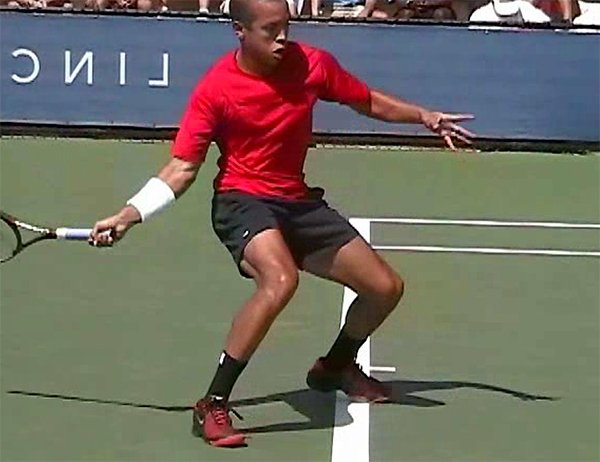
The next still is of Hicham Arazi - the great Moroccan player. Hover over the picture with your mouse to see how Arazi brings his arm forward, well in front of his body, as he turns his shoulders towards the net. On contact, his arm and shoulder are positioned beautifully behind the ball. And you see that trademark 45 degree angle between the upper arm and the side of the body. I really love this stroke because his hitting structure is identical in the both frames. The wrist and the angle of the elbow don't change. He simply takes this hitting structure and moves it forward and positions it behind the ball on impact for a very clean and powerful stroke.
Next we will look at an example of three very good players - two pro players and a non pro player - who are missing this critical piece. Their arms do not move in front of the body, and the upper arm does not form that critical 45 degree to the body on impact. Heather Watson fixed this problem the next time I filmed her, while Dudi Sela still has compromised leverage. The non pro player I have no idea what happened with his forehand because I didn't get a chance to work with him after noticing this flaw.